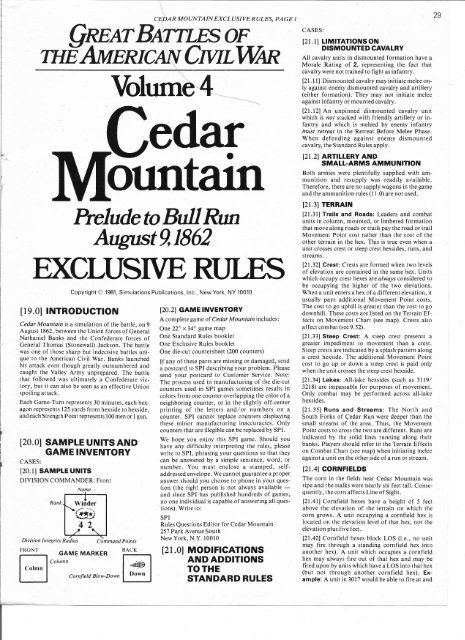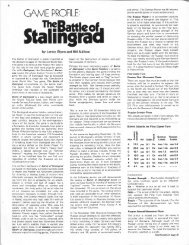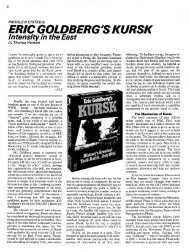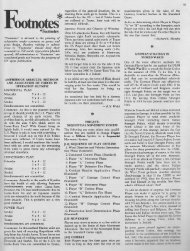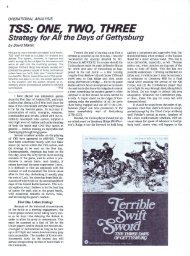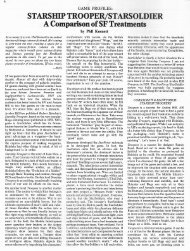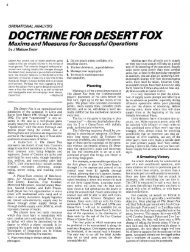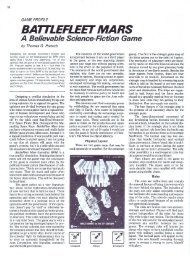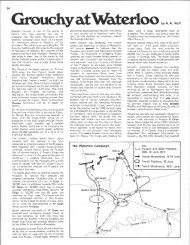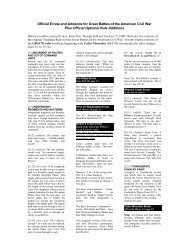Rules - Learning SPI's Great Battles of the American Civil War
Rules - Learning SPI's Great Battles of the American Civil War
Rules - Learning SPI's Great Battles of the American Civil War
- No tags were found...
Create successful ePaper yourself
Turn your PDF publications into a flip-book with our unique Google optimized e-Paper software.
Cy~AR MOUNTAIN EXCLUSIVE RULES, PAGE J{jREAT BArrTLES OF1HEAMERIC41¥ CIVIL WARVolumM- ~~~~~~~~~~~~~~-- .------.edarountainPrelude to Bull RunAugust 9,1862EXCLUSIVE RULES[19.0] INTRODUCTIONCopyright © 1981, Simulations Publications, Inc., New York, NY 10010Cedar Mountain is a simulation <strong>of</strong> <strong>the</strong> battle, on 9August 1862, between <strong>the</strong> Union forces <strong>of</strong> GeneralNathaniel Banks and <strong>the</strong> Confederate forces <strong>of</strong>General Thomas (Stonewall) Jackson. The battlewas one <strong>of</strong> those sharp but indecisive battles uniqueto <strong>the</strong> <strong>American</strong> <strong>Civil</strong> <strong>War</strong>. Banks launchedhis attack even though greatly outnumbered andcaught <strong>the</strong> Valley Army unprepared. The battlethat followed was ultimately a Confederate victory,but it can also be seen as an effective Unionspoiling attack.Each Game-Turn represents 30 minutes, each hexagonrepresents 125 yards from hexside to hexside,and each Strength Point represents 100 men or I gun.[20.0] SAMPLE UNITS ANDGAME INVENTORYCASES:[20.1] SAMPLE UNITSDIVISION COMMANDER: FrontRankDivision Integrity RadiusNameWinder.1",- -•.....,~4 2FRONT GAME MARKERIColm, IColumnCommand PointsCornfield Blow-DownBACKDownL..-_...J[20.2] GAME INVENTORYA completegame <strong>of</strong> Cedar Mountain includes:One 22" x 34" game mapOne Standard <strong>Rules</strong> bookletOne Exclusive <strong>Rules</strong> bookletOne die-cut countersheet (200 counters)If any <strong>of</strong> <strong>the</strong>se parts are missing or damaged, senda postcard to SPI describing your problem. Pleasesend your postcard to Customer Service. Note:The process used in manufacturing <strong>of</strong> <strong>the</strong> die-cutcounters used in SPI games sometimes results incolors from one counter overlapping <strong>the</strong> color <strong>of</strong> aneighboring counter, or in <strong>the</strong> slightly <strong>of</strong>f-centerprinting <strong>of</strong> <strong>the</strong> letters and! or numbers on acounter. SPI cannot replace counters displaying<strong>the</strong>se minor manufacturing inaccuracies. Onlycounters that are illegible can be replaced by SP!.We hope you enjoy this SPI game. Should youhave any difficulty interpreting <strong>the</strong> rules, pleasewrite to SPI, phrasing your questions so that <strong>the</strong>ycan be answered by a simple sentence, word, ornumber. You must enclose a stamped, selfaddressedenvelope. We cannot guarantee a properanswer should you choose to phone in your question(<strong>the</strong> right person is not always available -and since SPI has published hundreds <strong>of</strong> games,no one individual is capable <strong>of</strong> answering all questions).Write to:SPI<strong>Rules</strong> Questions Editor for Cedar Mountain257 Park Avenue SouthNew York, N.Y. 10010[21.0] MODIFICATIONSAND ADDITIONSTOTHESTANDARD RULESCASES:[21.1] LIMITATIONS ONDISMOUNTED CAVALRYAll cavalry units in dismounted formation have aMorale Rating <strong>of</strong> 2, representing <strong>the</strong> fact thatcavalry were not trained to fight as infantry.[21.11] Dismounted cavalry may initiate melee onlyagainst enemy dismounted cavalry and artillery(ei<strong>the</strong>r formation). They may not initiate meleeagainst infantry or mounted cavalry.[21.12] An unpinned dismounted cavalry unitwhich is not stacked with friendly artillery or infantryand which is meleed by enemy infantrymust retreat in <strong>the</strong> Retreat Before Melee Phase.When defending against enemy dismountedcavalry, <strong>the</strong> Standard <strong>Rules</strong> apply.[21.2] ARTILLERY ANDSMALL-ARMS AMMUNITIONBoth armies were plentifully supplied with ammunitionand resupply was readily available.Therefore, <strong>the</strong>re are no supply wagons in <strong>the</strong> gameand <strong>the</strong> ammunition rules (11.0) are not used.[21.3] TERRAIN[21.31] Trails and Roads: Leaders and combatunits in column, mounted, or limbered formationthat move along roads or trails pay <strong>the</strong> road or trailMovement Point cost ra<strong>the</strong>r than <strong>the</strong> cost <strong>of</strong> <strong>the</strong>o<strong>the</strong>r terrain in <strong>the</strong> hex. This is true even when aunit crosses crest or steep crest hexsides, runs, andstreams.[21.32] Crest: Crests are formed when two levels<strong>of</strong> elevation are contained in <strong>the</strong> same hex. Unitswhich occupy crest hexes are always considered tobe occupying <strong>the</strong> higher <strong>of</strong> <strong>the</strong> two elevations.When a unit enters a hex <strong>of</strong> a different elevation, itusually pays additional Movement Point costs.The cost to go uphill is greater than <strong>the</strong> cost to godownhill. These costs are listed on <strong>the</strong> Terrain Effectson Movement Chart (see map). Crests alsoaffect combat (see 9.52).[21.33] Steep Crest: A steep crest presents agreater impediment to movement than a crest.Steep crests are indicated by a splash pattern alonga crest hexside. The additional Movement Pointcost togo up or down a steep crest is paid onlywhen <strong>the</strong> unit crosses <strong>the</strong> steep crest hexside.[21.34] Lakes: All-lake hexsides (such as 3119/3218) are impassable for purposes <strong>of</strong> movement.Only combat may be performed across all-lakehexsides.[21.35] Runs and Streams: The North andSouth Forks <strong>of</strong> Cedar Run were deeper than <strong>the</strong>small streams <strong>of</strong> <strong>the</strong> area. Thus, <strong>the</strong> MovementPoint costs to cross <strong>the</strong> two are different. Runs areindicated by <strong>the</strong> solid lines running along <strong>the</strong>irbanks. Players should refer to <strong>the</strong> Terrain Effectson Combat Chart (see map) when initiating meleeagainst a unit on <strong>the</strong> o<strong>the</strong>r side <strong>of</strong> a run or stream.[21.4] CORNFIELDSThe corn in <strong>the</strong> fields near Cedar Mountain wasripe and <strong>the</strong> stalks were nearly six feet tall. Consequently,<strong>the</strong> corn affects Line <strong>of</strong> Sight.[21.41] Cornfield hexes have a height <strong>of</strong> 5 feetabove <strong>the</strong> elevation <strong>of</strong> <strong>the</strong> terrain on which <strong>the</strong>corn grows. A unit occupying a cornfield hex islocated on <strong>the</strong> elevation level <strong>of</strong> that hex, not <strong>the</strong>elevation plus five feet.[21.42] Cornfield hexes block LOS (i.e., no unitmay fire through a standing cornfield hex intoano<strong>the</strong>r hex). A unit which occupies a cornfieldhex may always fire out <strong>of</strong> that hex and may befired upon by units which have a LOS into that hex(but not through ano<strong>the</strong>r cornfield hex). Example:A unit in 3017 would be able to fire at and29
30be fired upon by a unit in 2816, but a unit in 2716could nei<strong>the</strong>r see nor be seen by <strong>the</strong> unit in 3017.[21.43] A cornfield hex may be "blown down" bySl~all-arms fire at a range <strong>of</strong> one hex or by artilleryfire at a range <strong>of</strong> three hexes or less. Once <strong>the</strong> hexhas been fired into, a Cornfield Blow-Downmal-ter is placed on <strong>the</strong> hex and it is consideredclea~ for all purposes for <strong>the</strong> rest <strong>of</strong> <strong>the</strong> game. lrnportent:A unit may not fire into an unoccupiedcornfield hex merely to blow down <strong>the</strong> corn;rathjr, <strong>the</strong> hex must be occupied by an enemy unit~ '::.:;:::ILLERYGENERAL RULE:.OVERSHOOTThe following rule is used to simulate <strong>the</strong>I sometimes gross inaccuracy <strong>of</strong> artillery fire at ex-I tended ranges. This fire tended to land before,behind and beside <strong>the</strong> intended target. Thus, whenan artillery unit fires at a target at a 9 or greater hexIrange, <strong>the</strong>re is a charice that <strong>the</strong> fire will miss <strong>the</strong>target and land in a hex adjacent to <strong>the</strong> hex <strong>the</strong>I target occupies.PROCEDURE:The following procedure is used to resolve all artilleryfire combats executed at a range <strong>of</strong> 9 hexesor greater:1. The player announces aloud an <strong>the</strong> artilleryunits which are combining fire against units in <strong>the</strong>same target hex.2. The player rolls one die for each firing unit andconsults <strong>the</strong> Overshoot Table (22.3) to determinewhe<strong>the</strong>r or not <strong>the</strong> battery has hit <strong>the</strong> target hex.The range is figured separately for each firing battery.The Overshoot Table results will indicatewhe<strong>the</strong>r <strong>the</strong> fire was accurate or scattered.3. All batteries which received an "accurate"result on <strong>the</strong> Overshoot Table have <strong>the</strong>ir strengthscombined and <strong>the</strong> combat is resolved normally using<strong>the</strong> Fire Combat Results Table.4. Batteries whose fire "scattered" now resolve<strong>the</strong>ir attacks. The player rolls one die for each batteryand compares <strong>the</strong> result with <strong>the</strong> ScatterDiagram printed on <strong>the</strong> map. A battery whose firescatters will attack one <strong>of</strong> <strong>the</strong> six hexes adjacent to<strong>the</strong> target hex. If <strong>the</strong> scatter hex is unoccupied byenemy units, <strong>the</strong>re is no combat; if occupied byenemy or friendly units, <strong>the</strong> player resolves a normalattack against <strong>the</strong> hex using <strong>the</strong> Fire CombatResults Table. The strengths <strong>of</strong> all batteries whichscatter into <strong>the</strong> same hex are combined as usualand are not treated as individual attacks.Example: Batteries in 3015 and 3318 combine toattack an enemy unit in 2207. "The player whoowns <strong>the</strong> batteries rolls one die per battery andcompares this result with <strong>the</strong> range from battery totarget on <strong>the</strong> Overshoot Table. The result for <strong>the</strong>battery in 3015 is "5," and thus <strong>the</strong> fire is accuratesince <strong>the</strong> range is between 9 and 15 hexes. Theresult for <strong>the</strong> battery in 3318 is "3," and thus <strong>the</strong>fire has scattered since <strong>the</strong> range was 16 or morehexes. A second die-roll is made and <strong>the</strong> result is"4"; <strong>the</strong> fire from this battery lands in hex 2208,which is unoccupied and thus has no effect.CASES:[22.1] INTENDED TARGETSOF ARTILLERY FIREA player may never attack a vacant hex in <strong>the</strong> hopethat his fire will overshoot into a hex containingenemy units. A target hex for artillery fire mustcontain an enemy unit or else <strong>the</strong> fire may not beexecuted.CEDAR MOUNTAIN EXCLUSIVE RULES, PAGE 2[22.2] TERRAIN, RANGEAND OVERSHOOTShould artillery fire scatter into a hex to which <strong>the</strong>firing unit does not have a clear Line <strong>of</strong> Sight, <strong>the</strong>fire is still executed normally. Ifa battery's firescatters into a hex outside that unit's maximumrange, <strong>the</strong> fire is still executed normally. Theabove two fire effects commonly occurred on <strong>the</strong>battlefield and thus have been included forhistorical accuracy.[22.3] OVERSHOOT TABLE(see map)[23.0] RETREAT ANDROUT MOVEMENTCOMMENTARY:The following rules are used to force players intoreconsidering those wide flanking actions gamersare so fond <strong>of</strong>. These wild excursions were rarelymade in <strong>the</strong> actual war and <strong>the</strong> following retreatlimits are meant to recreate <strong>the</strong> real importance <strong>of</strong>"friendly lines."GENERALRULE:Units which are forced to retreat (from melee, dueto rout, etc.) may never use <strong>the</strong> retreat as an "advance."Thus, when a unit retreats it must alwaysretreat towards its own lines (which are given inmap directions) and may not use <strong>the</strong> retreat as ameans <strong>of</strong> placing <strong>the</strong> unit in a more <strong>of</strong>fensively advantageousposition than <strong>the</strong> hex <strong>the</strong> unit occupiedbefore <strong>the</strong> retreat.CASES:[23.1] CONFEDERATE RETREATSWhen a Confederate unit retreats, it must alwaysretreat into a hex which is northwest, west orsouthwest <strong>of</strong> <strong>the</strong> hex it occupies. A Confederateunit may never retreat into a hex nor<strong>the</strong>ast, east orsou<strong>the</strong>ast <strong>of</strong> <strong>the</strong> hex it occupies. If <strong>the</strong> only hexfree <strong>of</strong> enemy units lies in this direction, <strong>the</strong> unit iscaptured ra<strong>the</strong>r than retreated. A unit may retreatthrough Union ZOC's, and indeed must, if this is<strong>the</strong> only path open to it. (Exceptions: see 12.82and 12.92).[23.2] UNION RETREATSA Union unit must always retreat into a hex that isnor<strong>the</strong>ast, east, or sou<strong>the</strong>ast <strong>of</strong> <strong>the</strong> hex it occupiesand may never retreat into a westerly direction. Ifforced to retreat to <strong>the</strong> west, northwest or southwest,<strong>the</strong> Union unit is captured. A unit mayretreat through a Confederate ZOC and must doso if that is <strong>the</strong> only path open to it.[24.0] BRIGADE COMBATEFFECTIVENESS LOSSCASES:[24.1] EFFECT ON INFANTRYAND CAVALRY[24.11] A 1 is added to <strong>the</strong> die-roll for all MoraleChecks made for' infantry and cavalry units <strong>of</strong> a _brigade that has lost BCE.[24.12] No unit in a brigade that has lost BCE mayinitiate melee. A unit defends normally whenmeleed by enemy units, and if it becomes engagedduring melee, it may melee normally.[24.13] Whenever a non-artillery unit in a brigade.that has lost BCE engages in fire combat, <strong>the</strong> FireStrength column is shifted one column to <strong>the</strong> left.This shift applies even if <strong>the</strong> unit is firing in combinationwith non-BCE loss units.[24.14] Units <strong>of</strong> a brigade which has reached BCEmay not voluntarily enter an enemy ZOC. If such aunit finds itself adjacent to an enemy unit at <strong>the</strong>start <strong>of</strong> its Movement Phase, it is not required toleave. In addition, a unit may not retreat throughan enemy ZOC at all, and if forced to, is capturedinstead.[24.15] A routed unit whose brigade has reachedBCE may only be rallied by a die-roll. The owningplayer rolls a die and if <strong>the</strong> result is equal to or lessthan <strong>the</strong> unit's Morale Rating, it rallies (remember24.11). To be rallied, <strong>the</strong> unit must be in <strong>the</strong> EffectivenessRadius <strong>of</strong> its brigade commander and thatcommander must spend a Rally Point (see 17 .13)to attempt to rally that unit. A unit which is stackedwith a brigade or division commander has a 1subtracted from its rally die-roll (<strong>the</strong> brigade commanderneed not expend a Rally Point). A unitwhich is stacked with a friendly army commander(ei<strong>the</strong>r General Banks or Jackson) rallies automaticallyregardless <strong>of</strong> BCE loss.[24.2] EFFECTS ON DETACHMENTA brigade that has reached its BCE limit may notbe detached from its division. If a detachedbrigade has not been attached to ano<strong>the</strong>r divisionand it reaches its BCE limit, <strong>the</strong>n it is "out <strong>of</strong> command."The brigade's leader may only move onehex per Game-Turn until <strong>the</strong> brigade is reattachedto some friendly division.[25.0] LEADERSHIP ANDLEADER LOSSCASES:[25.1] STONEWALL JACKSONGeneral Jackson has three Command Points (asindicated on his counter) which may be used eachGame-Turn to increase <strong>the</strong> Divisional IntegrityRadius <strong>of</strong> any Confederate division commander.The division commander must begin <strong>the</strong> ConfederateInitial Command Phase within threehexes <strong>of</strong> Jackson (exclusive). Jackson's threepoints may be split among his division commandersso long as each commander is within <strong>the</strong>three hex limit. In all o<strong>the</strong>r ways General Jacksonacts as a regular leader (i.e., he affects friendlymelee strengths, may rally routed units with whichhe is stacked, and so forth).[25.2] NATHANIEL BANKSGeneral BanKS has one Command Point whichmay be used each Game-Turn to increase <strong>the</strong> DivisionalIntegrity Radius <strong>of</strong> one Union divisionalcommander by one. Banks also acts as a regularleader for o<strong>the</strong>r game purposes.[25.3] LEADER REPLACEMENTWhenever a leader becomes a casualty, he must bereplaced by ano<strong>the</strong>r leader <strong>of</strong> his command, as per17.8 <strong>of</strong> <strong>the</strong> Standard <strong>Rules</strong>. When replacing aleader, <strong>the</strong> first replacement should be selected asindicated in <strong>the</strong> following secondary cases; if thatleader is already a casualty, <strong>the</strong> second replacementis selected, and so forth. Thus, a divisioncommander may only be replaced by ananonymous brigade commander replacement if all<strong>the</strong> leaders on <strong>the</strong> list <strong>of</strong> replacements for that divi- .sion are casualties.[25.31] General Banks and· General Jackson arenot replaced if <strong>the</strong>y become casualties or are captured.It is assumed that <strong>the</strong> highest ranking divisioncommander <strong>of</strong> <strong>the</strong>ir command has takenover. This is not reflected in game terms.[25.32] Union division commander Williams isreplaced first by Crawford and <strong>the</strong>n by Gordon.Augur is replaced by Geary, Prince, and Green inthat order.
[25.33) Confederate division commander Winderis replaced first by Taliaferro and <strong>the</strong>n Ronald.Hill is replaced by Branch, Pender, Archer, and<strong>the</strong>n Thomas. Ewell is replaced by Trimble and<strong>the</strong>n Forno.[25.34) A brigade commander who begins <strong>the</strong>game subordinate to a division commander may bepromoted, but an attached commander may neverbe promoted to command a division to which hedoes not belong (i.e., a brigade commander mayonly be promoted to command <strong>of</strong> his own division).This limitation is critical for detachedbrigades that are far from <strong>the</strong>ir division when <strong>the</strong>commander is required to take command <strong>of</strong> <strong>the</strong>division.[26.0] HOW TO STARTGENERALRULE:The Union army begins play deployed on <strong>the</strong> mapin <strong>the</strong> Union Deployment Areas printed on <strong>the</strong>map. The Confederate Army enters play startingon Game-Turn One as reinforcements from <strong>of</strong>f-map.CASES:[26.1] FIRST TURN SEQUENCE OF PLAYThe Union player is always <strong>the</strong> first player in <strong>the</strong>Sequence <strong>of</strong> Play. On Game-Turn One, however,<strong>the</strong> Union Player-Turn is omitted. Thus, <strong>the</strong> Confederateplayer moves first in <strong>the</strong> game.[26.2] UNION SET-UPThe Union OB Roster has printed on it <strong>the</strong>historical Deployment Areas for each <strong>of</strong> <strong>the</strong> Unionbrigades and artillery units. The player sets up all<strong>the</strong> units <strong>of</strong> a brigade on hexes within its DeploymentArea in any formation he wishes. EachUnion Deployment Area is indicated on <strong>the</strong> mapand consists <strong>of</strong> <strong>the</strong> central, numbered hex and <strong>the</strong>six adjacent, surounding hexes. The units may beset up in a stack within <strong>the</strong> limits <strong>of</strong> <strong>the</strong> stackingrestrictions for that hex type (see <strong>the</strong> StackingRestriction Chart on <strong>the</strong> map) in any hexes in <strong>the</strong>area. Brigade leaders are set up with, <strong>the</strong>irbrigades, divsion commanders may be set up withany brigade <strong>of</strong> its command, and General Banksmay beset upalongwithanyunit in <strong>the</strong> Union Army.[26.3] UNION OPTIONAL DEPLOYMENTIf both players agree, <strong>the</strong> following rule may be usedto alter <strong>the</strong> historical Union set up. The Unionplayer is free to set up his units in any DeploymentArea he chooses. One brigade (only), plus one battery,is deployed per Area. The 1st Me Cavalry isset up in area 1 and Bayard's brigade in Area 6. Allunits are still subject to 26.2, as well as <strong>the</strong> Sequence<strong>of</strong> Play in 26.1.[26.4] CONFEDERATE DEPLOYMENTThe Confederate player begins with no units on<strong>the</strong> map at <strong>the</strong> start <strong>of</strong> <strong>the</strong> game. His units 'enterplayas reinforcements on hexes and Game-Turnsspecified for each unit on <strong>the</strong> Confederate OBRoster. These units arrive in a column stretchingdown a road or trail (one behind <strong>the</strong> o<strong>the</strong>r) during<strong>the</strong> Confederate Movement Phase. The playersshould visualize <strong>the</strong> reinforcements as a string <strong>of</strong>units entering <strong>the</strong> map from a chain <strong>of</strong> road/trailhexes <strong>of</strong>f-map, so that <strong>the</strong> first unit spends (for example)one Movement Point; <strong>the</strong> second, twoMovement Points; <strong>the</strong> third three, and so forth.[26.41) Reinforcements may enter at any pointduring <strong>the</strong> Confederate Movement Phase. Theorder <strong>of</strong> arrival is also determined by <strong>the</strong> Confederateplayer.[26.42) Once a unit has entered <strong>the</strong> map, it maymove and attack just like any o<strong>the</strong>r unit alreadyCEDAR MOUNTAIN EXCLUSIVE RULES, PAGE 3present. Once a unit has entered <strong>the</strong> map it maynever leave. If its only path <strong>of</strong> retreat during routor retreat is <strong>of</strong>f map, it is considered captured by<strong>the</strong> enemy player.[26.43) Units which enter this map as reinforcementsare not subject to <strong>the</strong> limitations <strong>of</strong> leadershipuntil <strong>the</strong> Game-Turn after which <strong>the</strong>y enter<strong>the</strong> map.[26.44) If an entry hex is occupied by a Union unit,<strong>the</strong> units scheduled to enter <strong>the</strong>re are delayed aGame-Turn and <strong>the</strong>n entered in ei<strong>the</strong>r that hex, ifclear or <strong>the</strong> closest unblocked hex. Should twohexes be equidistant, <strong>the</strong> Confederate player hashis choice <strong>of</strong> hexes.[26.45) If <strong>the</strong>re are more reinforcing units scheduledto arrive than can physically be entered onto <strong>the</strong>map during a Game-Turn, <strong>the</strong> remaining <strong>of</strong>f-mapunits are simply brought into play on <strong>the</strong> followingGame-Turns.[26.46) Reinforcements always enter in column(infantry), mounted (cavalry) and limbered (artillery)formation.[27.0] HOW TO WINGENERALRULE:Victory is determined by <strong>the</strong> accumulation <strong>of</strong> VictoryPoints. Victory Points are awarded for inflictingcasualties on enemy combat units and leaders,and for controlling certain hexes at <strong>the</strong> end <strong>of</strong> eachGame-Turn. At <strong>the</strong> end <strong>of</strong> <strong>the</strong> game, both playerstotal <strong>the</strong>ir Victory Points. The smaller total is subtractedfrom <strong>the</strong> larger and <strong>the</strong> result is comparedto <strong>the</strong> schedule given in 27.1 to determine <strong>the</strong> level<strong>of</strong> victory.CASES:[27.1] LEVELS OF VICTORYDraw(in effect, <strong>the</strong> Union has wona moral victory)Marginal VictoryTactical Victory(historically, <strong>the</strong> Confederateswon a tactical victory)Strategic Victory(<strong>the</strong> Battle <strong>of</strong> Cedar Mountainhas major effects upon <strong>the</strong>Eastern Theater and on <strong>the</strong>upcoming campaign <strong>of</strong>Second Bull Run)[27.2] VICTORY POINTSOt056toVP's10VP'sIltol8VP's19 or more VP's[27.21) A player receives Victory Points for <strong>the</strong>elimination or capture <strong>of</strong> enemy Strength Points,guns, and leaders, and for enemy brigades whichhave reached <strong>the</strong>ir BCE limit.Enemy infantry Strength Point/gun:EliminatedCapturedEnemy cavalry Strength Point:EliminatedCapturedEnemy brigade commander:WoundedKilledCapturedEnemy division commander:WoundedKilledCapturedIf Jackson is a casualtyor captured, <strong>the</strong> Unionplayer receives:I VPeach2 VP's each2 VP's each3 VP's eachI VPeach2 VP's each3 VP's each3 VP's each5 VP's each8 VP's eachWoundedKilledCapturedIf Banks is a casualtyor captured, <strong>the</strong> Confederateplayer receives:WoundedKilledCaptured5 VP'sIOVP's15VP's3 VP's5 VP' s8 VP'sNote: A player receives no VP's for <strong>the</strong> elimination<strong>of</strong> enemy battery crews. If a brigade commanderhas been promoted, he is considered adivision commander for Victory Point purposes.The number <strong>of</strong> Victory Points awarded for anenemy brigade reaching its BCE limit is listed on<strong>the</strong> OB Roster next to that brigade.[27.22) Ei<strong>the</strong>r or both players may receive VictoryPoints for <strong>the</strong> occupation or control <strong>of</strong> certainVictory Point hexes (see map). Each <strong>of</strong> <strong>the</strong> hexes isworth 2 Victory points per Game- Turn for <strong>the</strong> controllingplayer. The Points are awarded at <strong>the</strong> end<strong>of</strong> <strong>the</strong> Confederate Player-Turn and are recordedon <strong>the</strong> Union OB Roster each Game-Turn. Important:All Victory Point hexes begin uncontrolledby ei<strong>the</strong>r player; thus, it is physically impossiblefor ei<strong>the</strong>r player to control any <strong>of</strong> <strong>the</strong> hexes at <strong>the</strong>conclusion <strong>of</strong> Game-Turn One. Control <strong>of</strong> a VictoryPoint hex is defined as having been <strong>the</strong> lastplayer to have actually occupied <strong>the</strong> hex with acombat unit.[27.23) Ei<strong>the</strong>r player may exit his units <strong>of</strong>f <strong>the</strong>map through hex 0101. To do so, a unit must occupy0101 and expend one Movement Point toleave <strong>the</strong> map. It is not eliminated, but it maynever return to play once removed. Units may onlybe exited during <strong>the</strong> friendly Movement Phase(<strong>the</strong>y are still eliminated if forced to retreat <strong>of</strong>f <strong>the</strong>map). Important: The Confederate player (only)receives one Victory Point for each combat unit orbattery exited <strong>of</strong>f <strong>the</strong> map. The Union player neverreceives VP's for exiting units.CEDAR MOUNTAINDESIGN CREDITSGame Design:David Bush, Jim Simon, Anthony WilliamsPhysical Systems and Graphics:Redmond A. SimonsenDevelopment and Additional Design:Eric Smith, Joseph ReiserOriginal Game System Design:Richard BergPlay testers:Andy Eiler, Philip Marchal, Randy Schadel,Gerry Klug, Doug BartonProduction:Carolyn Eelder, Ted Koller,Manfred F. Milkuhn, Michael Moore,Robert Ryer, Ken Stec31
32UNION 08 ROSTERINFANTRY and CAVALRY BRIGADESDesignationBanks 0Williams0Gordon 0ReplOCrawford 0ReplOAugur 0Geary 0ReplOPrince 0ReplOGreene 0ReplOBayard 0ReplOIndependent CavalryI MeARTILLERYDesignation6 Me4MeF, 4 USE,PaL,2NYM, I NYArea <strong>of</strong>Deploymentwith anyUnion unitwith anybrigade unit54with anybrigade unit32Brigade CombatEffectiveness LimitCEDAR MOUNTAIN EXCLUSIVE RULES, PAGE413<strong>of</strong> 190000000000000=12 VP's00000013<strong>of</strong> 180000000000000 = 17VP's000007 <strong>of</strong> II0000000 = 10VP's00008 <strong>of</strong> 1400000000 =9 VP's0000003 <strong>of</strong> 6000 =5 VP's0006 3 <strong>of</strong> 7000 = 10VP's0000Area <strong>of</strong>DeploymentI2Strength00000StrengthTBOOOOOOTAOOOOOONOOOOOOPAOOOOOOTBOOOOOOPAOOOOOOCONFEDERATE 08 ROSTERINFANTRY BRIGADESGame-Turn/ Brigade CombatDesignation Hex <strong>of</strong> Entry Effectiveness LimitJackson 0 2/2934Winder 0 2/2934Ronald 0 5/2934 6 <strong>of</strong> 10ReplOOOOOOO=16VP's0000Garnett 0 2/2934 4 <strong>of</strong> 7ReplO 0000 = 10VP's000Taliaferro 0 2/2934 7 <strong>of</strong> 13ReplO 0000000 = 14VP's000000Ewell 0 1/4032Trimble 0 1/4032 10<strong>of</strong> 20ReplO 0000000000= 16VP's0000000000Forno 0 1/4032 15<strong>of</strong> 30ReplO 000000000000000 =24 VP's000000000000000Hill 0 9/2934Branch 0 9/2934 10<strong>of</strong> 20ReplO 0000000000 =20 VP's0000000000Archer 0 10/2934 10<strong>of</strong> 20ReplO 0000000000 =22 VP's0000000000Thomas" 0 7/2934 14<strong>of</strong> 20Repl Tl 00000000000000 =30 VP's000000Pender 0 10/2934 10<strong>of</strong> 20ReplO 0000000000 = 16VP's0000000000* Thomas enters detachedINDEPENDENT UNITS3Game-Turn/ Brigade Combat4Designation Hex <strong>of</strong> Entry Effectiveness Limit5Early 0 1/2934 8 <strong>of</strong> 166ReplO 00000000 =30 VP's00000000White's.StrengthVICTORY POINT HEX POSSESSION TRACKCommanches 1/4032 0Victory PointGAME-TURNHex2319 1921 1323 3415 ) ARTILLERYIHOW TO USE THE OB ROSTERThe OB Roster (Order <strong>of</strong> Battle Roster) is used to record <strong>the</strong> losses sufferedby each army, to determine <strong>the</strong> time and place <strong>of</strong> entry for eon-23federate units, and <strong>the</strong> historical Set-up Areas for Union units. Each4time an infantry or cavalry unit suffers casualties, a number <strong>of</strong> boxes,equal to <strong>the</strong> number <strong>of</strong> Strength Points lost, are marked <strong>of</strong>f <strong>the</strong> BeE5section <strong>of</strong> that unit's brigade record. When <strong>the</strong> number <strong>of</strong> boxes6reaches <strong>the</strong> BeE limit, <strong>the</strong> brigade has lost effectiveness (see 24.0) and7<strong>the</strong> enemy player is awarded <strong>the</strong> number <strong>of</strong> Victory Points for that8brigade listed next to its BeE limit. Independent regiments and artilleryunits have losses recorded on <strong>the</strong>ir strength record, not a BeE section.9Leader losses are marked <strong>of</strong>f in <strong>the</strong> box next to <strong>the</strong> leader's name.10The symbols used to mark boxes are:II1213Key: U= Unioncontrolled;C= Confederatecontrolled;1-)= Uncontrolled(see27.22).• = Strength Point/Gun eliminated, and leader killed.~ = Strength Point/Gun/leader captured.ll! = Leader wounded.Retain one copy <strong>of</strong> <strong>the</strong> OB Roster without marks on it, since duplicatecopies will be needed to play <strong>the</strong> game more than once. SPI grants permissionto reproduce <strong>the</strong> OB Roster for personal use. Additional copiesare not available from SPI.Game-Turn/Designation Hex <strong>of</strong> Entry StrengthI Md 1/2934 NOOOO4Md 1/2934 TAOOOOBedford 1/2934 NOOOOAlleghany 2/2934 NOOOORockbridge 2/2934 PAOOOOHampden 2/2934 TBOOOOLa Guard 2/4032 NOOOOCourtney 2/4032 TBOOOOPurcell 4/2934 PAOOMiddlesex 4/2934 PAOO-,'"


